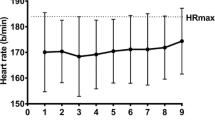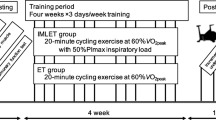Abstract
Repeated trials of hypercapnic exercise [ΔPETCO2=7 (1) mmHg] augment the increase in inspired minute ventilation and tidal volume (VT) in the early phase of subsequent trials of unencumbered exercise alone. The increase in VT in the first 20 s of exercise was correlated to the increase in VT evoked during hypercapnic exercise trials, suggesting that the evoked increase in VT during conditioning may be a factor in mediating associative conditioning. To test this hypothesis, inspiratory resistive loading (IRL) was employed to evoke an increase in VT [ΔVT=0.4 (0.1) lBTPS] during conditioning exercise trials [IRL+EX; ΔPETCO2=2 (1) mmHg]. IRL+EX associative conditioning elicited a significant augmentation of the early minute ventilation (+46%) and VT (+100%) responses to subsequent unencumbered exercise. The latter was correlated to the evoked increase in VT during associative conditioning with IRL+EX. The results support the hypothesis that an evoked increase in VT during associative conditioning could be a factor in eliciting long-term modulation of minute ventilation in subsequent unencumbered exercise. The results further indicated that the modulation of ventilation early in exercise is not due to sensitisation to repeated trials of either IRL or exercise alone. Associative conditioning may shape the ventilatory response to exercise through a process of motor learning. Data are presented as mean (SEM) unless otherwise stated.




Similar content being viewed by others
References
Adreani CM, Hill JM, Kaufman MP (1997) Responses of group III and IV muscle afferents to dynamic exercise. J Appl Physiol 82:1811–1817
Cerretelli P, Grassi B, Xi L, Schena F, Marconi C, Meyer M, Ferretti G (1995) The role of pulmonary CO2 flow in the control of the phase I ventilatory response to exercise in humans. Eur J Appl Physiol 71:287–294
Collins DF, Burke D, Gandevia SC (2001) Large involuntary forces consistent with plateau-like behaviour of human motoneurons. J Neurosci 21:4059–4065
Corfield DR, Murphy K, Guz A (1998) Does the motor cortical control of the diaphragm ‘bypass’ the brain stem respiratory centres in man. Respir Physiol 114:109–117
Cummin ARC, Iyawe VI, Mehta N, Saunders KB (1986) Ventilation and cardiac output during the onset of exercise and during voluntary hyperventilation in humans. J Physiol (Lond) 370:567–583
Dejours P (1964) Control of respiration in muscular exercise. In: Fenn WO, Rahn H (eds) Handbook of physiology, section 3. Respiration, vol 1. American Physiology Society, Washington DC, pp 631–648
Fink GR, Corfield DR, Murphy K, Kobayashi I, Dettmers C, Adams L, Frackowiack RSJ, Guz A (1996) Human cerebral activity with increasing inspiratory force: a study using positron emission tomography. J Appl Physiol 81:1295–1305
Gandevia SC, Rothwell JC (1987) Activation of the human diaphragm from the motor cortex. J Physiol (Lond) 384:109–118
Gorassini M, Bennett DJ, Yang JF (1998) Self-sustained firing of human motor units. Neurosci Lett 247:13–16
Gozal D, Omidvar O, Kirlew KAT, Hathout GM, Hamilton R, Zhang J, Lufkin RB, Harper RM (1996) Identification of human brain regions underlying responses to inspiratory loading with functional magnetic resonance imaging. Proc Natl Acad Sci U S A 92:6607–6611
Hayashi F, Hinrichsen CFL, McCrimmon DR (2003) Short-term plasticity of descending synaptic input to phrenic motoneurons in rats. J Appl Physiol 94:1421–1430
Helbling D, Boutellier U, Spengler CM (1997) Modulation of the ventilatory increase at the onset of exercise in humans. Respir Physiol 109:219–229
Isaev G, Murphy K, Guz A, Adams L (2002) Areas of the brain concerned with ventilatory load compensation in awake man. J Physiol (Lond) 539:935–945
Johnson RA, Mitchell GS (2001) p-Chlorophenylalanine eliminates long-term modulation of the exercise ventilatory response in goats. Respir Physiol 128:161–169
Karni A, Meyer G, Rey-Hipolito C, Jezzard P, Adams MM, Turner R, Ungerleider LG (1998) The acquisition of skilled motor performance: fast and slow experience-driven changes in primary cortex. Proc Natl Acad Sci U S A 95:861–868
Knaflec M, Davenport PW (1999) Relationship between magnitude estimation of resistive loads, inspiratory pressures and the RREP P1 peak. J Appl Physiol 87:516–522
Martin PA, Mitchell GS (1993) Long term modulation of the exercise ventilatory response in goats. J. Physiol (Lond) 470:601–617
Moosavi SH, Guz A, Adams L (2002) Repeated exercise paired with “imperceptible” dead space loading does not alter VE of subsequent exercise in humans. J Appl Physiol 92:1159–1168
Somjen GG (1992) The missing error signal—regulation beyond negative feedback. News Physiol Sci 7:184–185
Sumners DP, Turner DL (2003) Long-term modulation of the leg exercise ventilatory response is not elicited by hypercapnic arm exercise. Respir Physiol Neurobiol 138:107–114
Turner DL, Jackson SW (2002) Resistive loaded breathing has a functional impact on isometric contractions in man. Neurosci Lett 326:77–80
Turner DL, Sumners DP (2002) Associative conditioning of the exercise ventilatory response in humans. Respir Physiol Neurobiol 132:159–168
Turner DL, Bach KB, Martin PA, Olsen EB, Brownfield M, Foley KT, Mitchell GS (1997) Modulation of ventilatory control during exercise. Respir Physiol 110:277–285
Turner DL, Sumners DP, Jackson SW (2000) Changes in electromyogram during upper limb muscle contraction induced by resistive loaded breathing in humans. Neurosci Lett 296:45–48
Wagner PG, Eldridge FL (1991) Development of short-term potentiation of respiration. Respir Physiol 83:129–140
Waldrop TG, Eldridge FL, Iwamoto GA, Mitchell JH (1996) In: Rowell LB, Shephard JT (eds) Handbook of physiology, section 12. Exercise. Oxford University Press, Oxford, pp 333–380
Wolpaw JR, Tennissen AM (2001) Activity-dependent spinal cord plasticity in health and disease. Annu Rev Neurosci 24: 807–843
Wood HE, Fatemian M, Robbins PA (2003) A learned component of the ventilatory response to exercise in man. J Physiol (Lond) 553:967–974
Acknowledgements
The Wellcome Trust (052854) and Nuffield Foundation (97/0343) funded this project.
Author information
Authors and Affiliations
Corresponding author
Rights and permissions
About this article
Cite this article
Turner, D.L., Stewart, J.D. Associative conditioning with leg cycling and inspiratory resistance enhances the early exercise ventilatory response in humans. Eur J Appl Physiol 93, 333–339 (2004). https://doi.org/10.1007/s00421-004-1194-2
Accepted:
Published:
Issue Date:
DOI: https://doi.org/10.1007/s00421-004-1194-2




